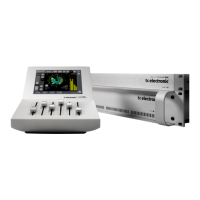64
brICkwAll 2
Introduction
Do we need another Limiter?
Several golden ears in pro audio believe that the best
soundinpop/rockmusicgenerallywasproducedbetween
1982and1995.Despitehigherresolutioninconverters
andDSP,lowerjitterandprobablyabetteroverall
understanding of digital media, we seem to be on a
declining rather than inclining sound quality slope these
years; even though people buying records and film may not
be aware of it.
Obviously, there could be many reasons for this we cannot
directly influence: Trends, basic recording and microphone
placementskills,moresemi-proequipmentbeingused,
shorter production times and therefore less attention to
detail etc.
The last couple of years, however, TC through papers
givenatAESconventionshasproventhatatleastone
good reason for trashy end listener and radio sound
exists: The abuse of loudness maximizers in mastering.
Whenlevelsgetsquashedagainstfullscale,0dBFS,
reconstructedintersamplepeaksinDAandsamplerate
converters may be considerable higher than the level
downstream equipment was designed to handle. We call
thislevel“0dBFS+”,andnocurrentrulesinmastering
preventssuchpeaksfromhappening.
TheBrickWalllimiterisdesigned:
1) to investigate if your signal is contaminated with
0dBFS+peaks
2) to remove them
If you are concerned about audio quality at the end listener,
or have a desire to conserve talent, we believe you need
alimiterwiththesevirtues.TheBrickWalllimitercannot
prevent destruction of dynamic range from happening at
earlier stages in the production process, but it can get rid of
thesignalsweknowaregoingtogetdistortedinconsumer
CD players, radio processors or data reduction codecs.
Precision in Level and Time
TheBrickWalllimiteroperateswithextendedprecision
inbothlevel(48bitthroughout)andtime(5times
oversampling). Double precision calculations are always
used, while hyper-precision in limiter timing can be turned
on or off using the Upsamplekey.
Level meters are always upsampled in order to identify
intersampleand0dBFS+peaksonInputsaswellas
Outputs.Themeterscaleisextendedto+3dBFSbecause
excessivelevelnormallyfallsbetween0and+3dBFS,
and most consumer equipment already exhibits severe
distortionat+0.5dBFS.
WerecommendusingtheBrickWalllimiterinUpsample
mode.However,ifyouwishtojustlimitthesignalbasedon
samplebysamplevalueslikeanormaldigitallimiter,the
function can be turned off. When turned off the limiter does
notprotectagainst0dBFS+peaksfromoccurring.
Limiter Time constants
Limiter Time constants
AnotherimportantfeatureofBrickwall2isitsadaptivetime
constants. Several internal timing parameters and detection
variables are constantly updated to combat low frequency
distortionwhilemaintainingquickadoptiontooccasional
peaks.Controlisappliedmodelinganalogdynamics
behavior in order to avoid introducing discontinuities and
out of band dirt to the signal.
Yearsofresearchintostatic,dynamicand0dBFS+
distortion in digital dynamics processing is built into
Brickwall2whenAdaptiveisactivated.Therefore,theuse
of Adaptive Profiles is recommended. If you turn off the
Adaptive setting, internal variables other than Release
Time will be fixed.
Absolute Bit Transparency
WhenevertheBrickWalllimiterisnotattenuatingthesignal,
it is passed completely unaffected, transparent to the 24th
bit.Consequently,theBrickWalllimitermaybeusedto
remove0dBFS+peaksonalreadymasteredandfinally
dithered material. When the Limiter is bit transparent, a
green indicator next to the Threshold control lights up.
Input and Output gain controls have 0.1dB increments, but
snap to bit shifts at 0, 6, 12, 18 and 24dB settings. When
a bit shift value is selected, a green indicator is lit on the
screen. Bit transparency from Input to Output is obtained
whenInputGainandOutputFaderhitthesevaluesand
sumto0dB,e.g.Input/Output0/0dB,-6/+6dB,-12/+12dB
etc.
Bit Pattern Transparency
When only bit shift gain settings are used on Input and
Output, bit patterns remain unchanged through the
algorithm, but can be shifted up (in the MSB direction) or
down(intheLSBdirection)asdesired.E.g.Input/Output
+6/0(oneup),0/-12(twodown).
Linking
ThetwochannelsBrickWalllimiterscanbeoperated
independentlyorlinked.Ifpronouncedlimitingisperformed
onstereomaterial,linkingshouldbeconsideredtoavoid
L/R image shifts. If only mild and occasional limiting is
beingdone,un-linkedoperationevenonstereomaterial
may sound the best.
The Brickwall Limiter occupies:
@ Normal Sample Rate : 1/4 DSP Resource
@ Double Sample Rate : 1/4 DSP Resource
Algorithm Inputs/Outputs are distributed as follows:
E1 - E4
L
R
L
R
INPUT
OUTPUT
•
•
•
•
•
•
•
•
•
•
•
•
•
•
•
•

